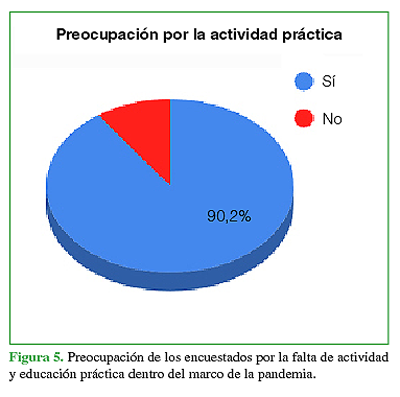Qualitative analysis of the Orthopedics and Traumatology residency system in times of COVID-19
Main Article Content
Abstract
Objective: To carry out a qualitative analysis of the Orthopedics and Traumatology residency system in the city of Buenos Aires and the Pampeana region during the COVID-19 pandemic.
Materials and Methods: A cross-sectional study was carried using an anonymous survey of 16 multiple-choice questions oriented to changes perceived regarding the theoretical and practical training during the pandemic. The survey was distributed to 361 Orthopedics and Traumatology resident doctors who work in the city of Buenos Aires and the Pampeana region.
Results: We received 122 answered surveys. Regarding their theoretical education, 76.2% of respondents stated that they were devoting more time to study than before the pandemic, and 71.3% that they were not worried about their theoretical education. The practical training perceptions present a different scenario as 88.5% of respondents stated that their surgical activities decreased and 90.1% expressed their concern regarding this situation.
Conclusions: Residents are aware of the impact that the quarantine has on their training and many of them are using this period to improve their theoretical education. To rise to this challenge, relying on various strategies, such as telemedicine, webinars, and videos on surgical procedures, is essential. However, this unprecedented circumstance has made us aware of the major challenge involved in replacing practical training.
Key words: Coronavirus; pandemic; medical training; residency; COVID-19.Level of Evidence: IV
Downloads
Metrics
Article Details
Manuscript acceptance by the Journal implies the simultaneous non-submission to any other journal or publishing house. The RAAOT is under the Licencia Creative Commnos Atribución-NoComercial-Compartir Obras Derivadas Igual 4.0 Internacional (CC-BY-NC.SA 4.0) (http://creativecommons.org/licences/by-nc-sa/4.0/deed.es). Articles can be shared, copied, distributed, modified, altered, transformed into a derivative work, executed and publicly communicated, provided a) the authors and the original publication (Journal, Publisher and URL) are mentioned, b) they are not used for commercial purposes, c) the same terms of the license are maintained.
In the event that the manuscript is approved for its next publication, the authors retain the copyright and will assign to the journal the rights of publication, edition, reproduction, distribution, exhibition and communication at a national and international level in the different databases. data, repositories and portals.
It is hereby stated that the mentioned manuscript has not been published and that it is not being printed in any other national or foreign journal.
The authors hereby accept the necessary modifications, suggested by the reviewers, in order to adapt the manuscript to the style and publication rules of this Journal.
References
https://aaot.org.ar/residencias/residencias-acreditadas. (Consulta: 8 de mayo, 2020)
2. Caviglia H. La educación médica en el ámbito de la Asociación Argentina de Ortopedia y Traumatología. Rev Asoc Argent Ortop Traumatol 2015;80(1):4-5. https://doi.org/10.15417/488
3. Borracci RA, Alvarez-Gallesio JM, Ciambrone G, Mezzadri NA. Autoestimación de habilidades y competencias
quirúrgicas basadas en la teoría de la curva de aprendizaje en médicos residentes y becarios. Cir Cir 2019;87(4):
416-22. https://pesquisa.bvsalud.org/portal/resource/%20es/mdl-31264986
4. Scullen T, Mathkour M, Maulucci CM, Dumont AS, Bui CJ, Keen JR. Impact of the COVID-19 pandemic on
Neurosurgical Residency Training in New Orleans.World Neurosurg 2020;139:718-9. https://doi.org/10.1016/j.wneu.2020.04.208
5. Balakrishnan Ashokka, Say Yang Ong, Kwang Hui Tay, Ne Hooi Will Loh, Chen Fun Gee, Dujeepa D.
Samarasekera. Coordinated responses of academic medical centres to pandemics: Sustaining medical education
during COVID-19. Med Teach 2020;42(7):762-71. https://doi.org/10.1080/0142159X.2020.1757634
6. Vacantes de residentes. Asociación Argentina de Ortopedia y Traumatología. Disponible en: https://docs.google.com/spreadsheets/d/17XFGSn4kbagI2Nrt9BRp3jQn0giqHJ9S-FAjDCk_WJI/edit#gid=0. (Consulta: 8 de mayo, 2020)
7. Encuesta sobre la Influencia COVID-19 en la Actividad de los Traumatólogos en Argentina. Encuesta de la
Asociación Argentina de Ortopedia y Traumatología. Disponible en: https://es.surveymonkey.com/r/QYWYN7W.
(Consulta: 8 de mayo, 2020)
8. Muñoz P N, Campaña W N, Campaña V G. Prevalencia del síndrome de burnout en los residentes de cirugía general de Chile y sus factores asociados. Rev Chil Cir 2018;70(6):544-50. http://dx.doi.org/10.4067/s0718-40262018000600544
9. Cattáneo A, Coppola EF, Federico Medina A, Pachón Guzmán A. Manejo y tratamiento de pacientes en áreas
quirúrgicas durante la pandemia COVID-19 Revisión en el área de Ortopedia y Traumatología. Rev Asoc Argent
Ortop Traumatol 2020;85(2):174-83. https://doi.org/10.15417/issn.1852-7434.2020.85.2.1101
10. Liebensteiner MC, Khosravi I, Hirschmann MT, Heuberer PR. Massive cutback in orthopaedic healthcare services due to the COVID‐19 pandemic. Knee Surg Sports Traumatol Arthrosc 2020; Apr 30:1-7.
https://doi.org/10.1007/s00167-020-06032-2
11. Connor Chick R, Clifton GT, Peace KM, Propper BW, Hale DF, et al. Using technology to maintain the education
of residents during the COVID-19 pandemic. Brooke Army Medical Center, San Antonio, Texas; and University of
California at San Francisco, San Francisco, California. J Surg Educ 2020;77(4):729-32. https://doi.org/10.1016/j.jsurg.2020.03.018
12. Schwarzkopf R, Maher NA, Slover JD, Strauss EJ, Bosco JA, Zuckerman JD. The response of an Orthopedic
Department and Specialty Hospital at the epicenter of a pandemic: the NYU Langone Health Experience. J
Arthroplasty 2020;35(7S):S3-S5. https://doi.org/10.1016/j.arth.2020.04.041
13. Tello C, Vedoya S, Autorino C, Varaona J, Peláez R, Fazio A, et al. Encuesta dirigida a los Residentes sobre aspectos de la Residencia de Ortopedia y Traumatología. Rev Asoc Argent Ortop Traumatol 2017;82(2):150-6.
https://doi.org/10.15417/694

